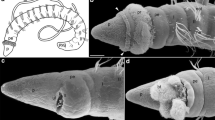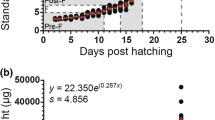Abstract
Polychaetes show a remarkable diversity of the respiratory system structures. However, the ultrastructure of gills was studied only in some species from several families. The morphology and ultrastructure of the gills of Ophelia limacina, Ophelina acuminata, Euzonus arcticus, and Travisia forbesii (Opheliidae) were studied using light microscopy, scanning electron microscopy, and transmission electron microscopy. Gills could be interpreted as body wall protrusions containing coelom, blood lacunas, or vessels connected to interepithelial blood sinuses. The blood is separated from the environment by a 1.5-μm thick wall in E. arcticus, 2-μm in O. limacine and T. forbesii, and 3-μm in O. acuminata, which is close to the minimum observed in the polychaetes; it refers to the effective gas exchange. Unlike the other species, the gill surface lacks cilia in T. forbesii. This might be explained by the fact that the body of T. forbesii is covered with a thick layer of mucus making cilia inefficient and leading to their reduction. The cuticle of the gills is thin; its structure in O. acuminata, O. limacina, and E. arcticus resembles the cuticle covering the other part of the body. In T. forbesii, the gills are covered with a protocuticle close to that in larval forms of polychaetes. The epidermal cells of gills are different in form in all four species studied. The epithelial cells in E. arcticus have few organelles, but contain numerous vacuoles, which represent a low level of synthesis. Therefore, they are likely to have a support function. The epithelium in O. limacina, O. acuminata, and E. arcticus has multiple gland cells, while T. forbesii does not have any. The gills of O. acuminata contain glands of two types, while O. limacine and E. arcticus have only one type of gill gland. The epidermal cells in T. forbesii are connected by desmosomes, while in the other three species, they also have dense junctions, and even adhesive belts in O. limacina and E. arcticus. The coelom is lined with mioepithelium, and in E. arcticus, together with podocites. Blood cells of O. limacina, O. acuminata, and E. arcticus were found for the first time, while in O. limacina, amoebocytes form an incomplete endothelium on basal lamina. The gills of T. forbesii differ from those of the other three Opheliid species in anatomy and some ultrastructural features. These data together with the results of recent molecular studies could be one more reason to exclude Travisia from Opheliidae. Furthermore, several common anatomic and ultrastructural features of O. limacina, O. acuminata, and E. arcticus could serve as a synapomorphy of the family Opheliidae. However, further anatomical and ultrastructural investigations are necessary before we can use this character for phylogenetic analysis.
Similar content being viewed by others
References
Bartolomaeus, T. and Quast, B., Structure and development of nephridia in Annelida and related taxa, Hydrobiologia, vols. 535/536, pp. 139–165.
Bleidorn, C., Vogt, L., and Bartolomaeus, T., New insights into polychaete phylogeny (Annelida) inferred from 18S rDNA sequences, Mol. Phylog. Evol., 2003, vol. 29, pp. 279–280.
Chentsov, Yu.S., Vvedenie v kletochnuyu biologiyu (A Primer in Cell Biology), Moscow: Akademkniga, 2004, pp. 254–268.
Gardiner, S.L., Respiratory and feeding appendages, in The Ultrastructure of Polychaeta, Westheide, W. and Hermans, C.O., Eds., Microfauna Marina, vol. 4, New York: Gustav Fischer 1988, pp. 37–43.
Hall, K.A., Hutchings, P.A., and Colgan, D.J., Further phylogenetic studies of the Polychaeta using 18S rDNA sequence data, J. Mar. Biol. Assoc. UK, 2004, vol. 84, pp. 949–960.
Hanso, J., The blood system in the Serpulimorpha (Annelida, Polychaeta): 2. The anatomy of the blood system in the Sabellidae, and comparison of Sabellidae and Serpulidae, Quart. J. Microsc. Sci., 1950, vol. 91, pp. 369–378.
Hourdez, S. and Jouin-Toulmond, C., Functional anatomy of the respiratory system of Branchipolynoe species (Polychaeta, Polynoidae), commensal with Bathymodiolus species (Bivalvia, Mytilidae) from deep-sea hydrothermal vents, Zoomorphology, 1998, vol. 118, pp. 225–233.
Jouin, C. and Toulmond, A., The ultrastructure of the gill of the lugworm Arenicola marina (L.) (Annelida, Polychaeta), Acta Zool., 1989, vol. 70, no. 2, pp. 121–129.
Mangum, C.P., Woodin, B.R., Bonaventura, C., Sullivan, B., and Bonaventura, J., The role of coelomic fluid and vascular hemoglobin in the annelid family Terebellidae, Comp. Biochem. Physiol., 1975, vol. 51, pp. 281–294.
Menendez, A., Arias, J., Tolivia, D., and Alvarez-Uria, M., Ultrastructure of the gill epithelial cells of Diopatra neapolitina (Annelida, Polychaeta), Zoomorphology, 1984, vol. 104, pp. 304–309.
Nicoll, P.A., The anatomy and behaviorof the vascular systems in Nereis virens and Nereis limbata, Biol. Bull., 1954, vol. 106, pp. 69–82.
Paul, C., Halanych, K.M., Tiedemann, R., and Bleidorn, C., Molecules reject an opheliid affinity for Travisia (Annelida), Syst. Biodiv., 2010, vol. 8, pp. 507–512.
Persson, J. and Pleijel, F., On the phylogenetic relationships of Axiokebuita, Travisia, and Scalibregmatidae (Polychaeta), Zootaxa, 2005, no. 998, pp. 1–14.
Rouse, G.W. and Pleijel, F., Polychaetes, Oxford, UK: Oxford Univ. Press, 2001, pp. 53–56.
Silva, G.S., Filogenia de Opheliidae (Annelida: Polychaeta), Ph.D. Thesis, Universidade Federal do Paraná, Brazil, 2007.
Stekol’shchikov, M.G., Structure and evolution of respiratory organs in polychaetes, Uch. Zap. Kazan. Gos. Univ., 1954, vol. 114, pp. 23–53.
Storch, V. and Alberti, G., Ultrastructural observations on the gills of Polychaeta, Helg. Wiss. Meeresunters., 1978, vol. 31, pp. 169–179.
Storch, V. and Gaill, F., Ultrastructural observations on feeding appendages and gills of Alvinella pompejana (Annelida, Polychaeta), Helg. Wiss. Meeresunters., 1986, vol. 40, pp. 309–319.
Temereva, E.N. and Malakhov, V.V., Ultrastructure of the circulatory system of the phoronid Phoronopsis harmeri Pixell, 1912: 2. Main vessels, Russ. J. Mar. Biol., 2004, vol. 30, no. 2, pp. 101–112.
Zhadan, A.E., Vortsepneva, E.V., and Tzetlin, A.B., Redescription and biology of Cossura pygodactylata Jones, 1956 (Polychaeta: Cossuridae) in the White Sea, Invert. Zool., 2012, vol. 9, no. 2, pp. 115–125.
Author information
Authors and Affiliations
Corresponding author
Additional information
Original Russian Text © P.A. Belova, A.E. Zhadan, 2014, published in Zoologicheskii Zhurnal, 2014, vol. 93, No. 3, pp. 443–465.
Rights and permissions
About this article
Cite this article
Belova, P.A., Zhadan, A.E. Comparative morphology and ultrastructure of the respiratory system in four species of the Opheliidae family. Biol Bull Russ Acad Sci 41, 752–772 (2014). https://doi.org/10.1134/S1062359014090040
Received:
Published:
Issue Date:
DOI: https://doi.org/10.1134/S1062359014090040




